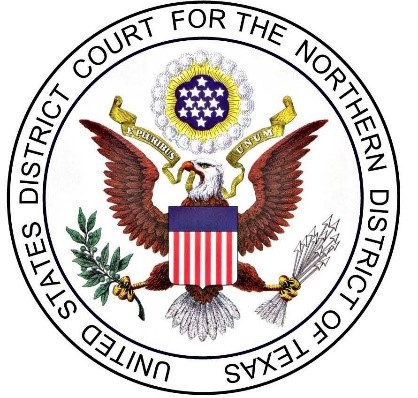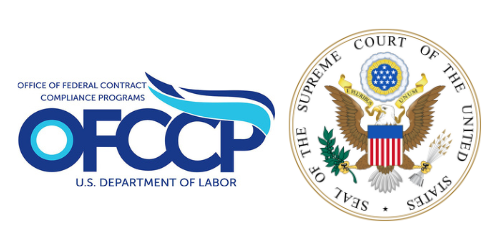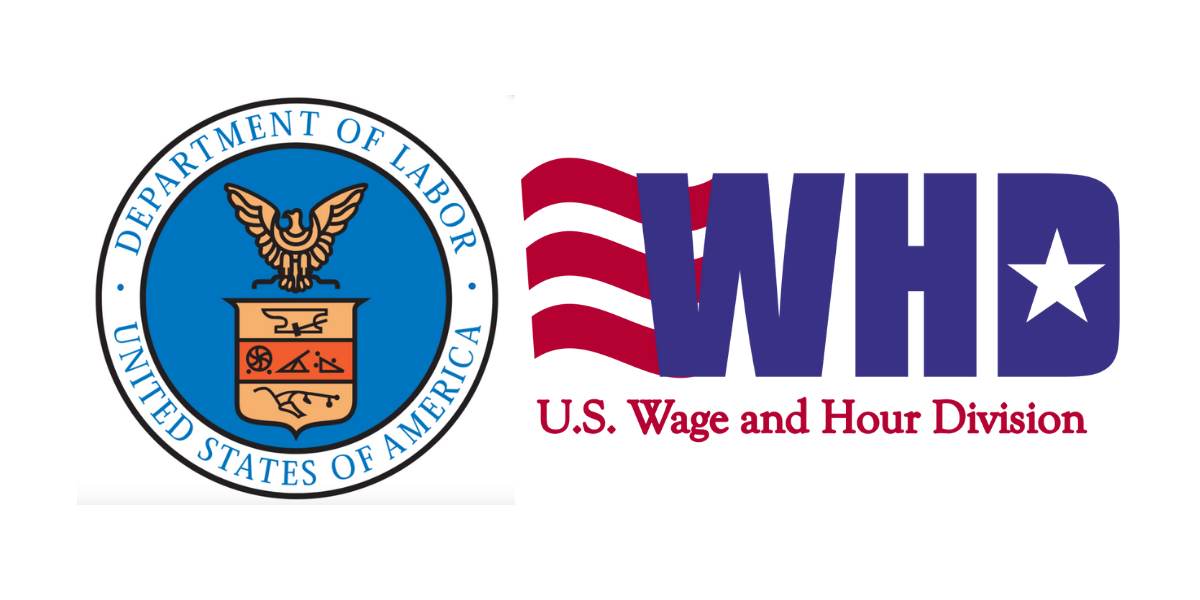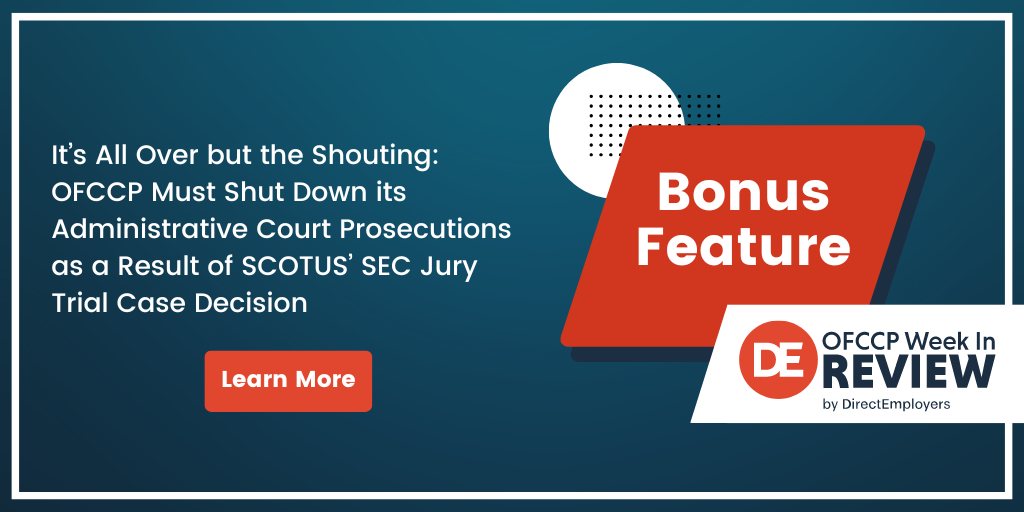
- Federal Judge Temporarily Blocked Portions of USDOL Rule Setting New Formula for Prevailing Wages on Federal Construction ProjectsStory 1
- It’s All Over but the Shouting: OFCCP Must Shut Down its Administrative Court Prosecutions as a Result of SCOTUS’ SEC Jury Trial Case Decision
- U.S. Supreme Court Dissolved Decades-Old Precedent Giving Court Deference to Federal Agency Interpretations of The Laws They Enforce
- In Brief
- New Publications
- Looking Ahead: Upcoming Date Reminders
Monday, June 24, 2024: Federal Judge Temporarily Blocked Portions of USDOL Rule Setting New Formula for Prevailing Wages on Federal Construction Projects

Of greatest concern was that U.S. DOL’s Wage and Hour Division (“WHD”) had changed the federal government’s formula used to set prevailing wages on federal construction projects. (The Devil is always in the details). In a 40-page decision, U.S. District Judge Sam Cummings in the Northern District of Texas (Lubbock) concluded that the WHD had “engaged in egregious violations” of the U.S. Constitution because it exceeded its authority under the DBA when it promulgated certain portions of the Rule.
Judge Cummings enjoined portions of the Rule providing that government agencies are not required to explicitly include prevailing wage standards in contracts. He also blocked a portion of the Rule extending coverage to truck drivers who make deliveries to work sites and another portion extending to material suppliers owned and operated by general contractors or subcontractors. (More details are provided below.) The case is Associated General Contractors of America v. U.S. Department of Labor, No. 5:23-cv-00272.
How We Got Here
On August 23, 2023, the WHD published its controversial Final Rule updating its Davis-Bacon and Related Act Regulations (“DBRA”) to increase prevailing wages on public construction projects (for details on this Final Rule, see our story here). The Final Rule took effect on October 23, 2023.
Enacted in 1931, the DBA requires the payment of prevailing wages and fringe benefits to laborers and mechanics who work on federal or District of Columbia contracts in excess of $2,000 for the construction, alteration, or repair of public buildings and public works. Congress subsequently incorporated DBA prevailing wage requirements into numerous statutes (referred to as “Related Acts”) under which federal agencies assist construction projects through grants, loans, loan guarantees, insurance, and other methods.
According to a WHD press release, the Final Rule contained the “most comprehensive updates in 40 years” to the regulations including an update to the formula the government uses to set prevailing wages. Among the provisions of the Rule were changes to specific definitions and a provision applying DBRA clauses and wage determinations to contracts by operation of law, even if they are mistakenly left out of a federal contract.
EDITORIAL NOTE: Current case law is to the same effect. Nothing new here, just codifying existing law for the past 50 years. However, those case decisions are controversial. Smaller construction contractors are often unaware of the DBA implications for their contract bids and contract performance obligations in the absence of warning language in Requests for Proposals and in winning construction contracts.
What Portions of the Rule Did Judge Cummings Strike?
The judge concluded that:
“Defendants engaged in egregious violations of Article II, section 3 of the Constitution, because rather than taking care to faithfully execute the DBA, Defendants instead usurped Congress’ law-making power and attempted substantive amendments to the DBA. Presidents and their agencies act ultra vires and do violence to the Constitution when they attempt to unilaterally amend Acts of Congress to suit their policy choices. Under Article I, section 1 of the Constitution, Presidents and their agencies cannot amend by executive fiat acts of Congress. Doing so violates the Constitution, and this preliminary injunction shall be issued to prevent this blatantly unlawful action.” [embedded links added]
Judge Cummings’ nationwide injunction will stay in effect pending a final resolution of the merits of the case or until further orders from him, the U.S. Court of Appeals for the Fifth Circuit (New Orleans), or the U.S. Supreme Court.
Specifically, the injunction bars the DOL WHD from implementing and enforcing the following portions of the regulations (detailed on pages 38-39 of the judge’s decision):
- §5.2 – specifically the definition of “Construction, prosecution, completion, or repair” set forth at subsection (iv)(D) and which provides [“Covered Transportation,” defined as any of the following activities:] “Onsite activities essential or incidental to offsite transportation,” defined as activities conducted by a truck driver or truck driver’s assistant on the site of the work that are essential or incidental to the transportation of materials or supplies to or from the site of the work, such as loading, unloading, or waiting for materials to be loaded or unloaded, but only where the driver or driver’s assistant’s time spent on the site of the work is not de minimis.”
- §5.2 – specifically the definition of “Material supplier” set forth at subsection (2) which provides “If an entity, in addition to being engaged in the activities specified in paragraph (1)(i) of this definition, also engages in other construction, prosecution, completion, or repair work at the site of the work, it is not a material supplier”; and
- §5.5(e) – (which provides “lncorporation by operation of law. The contract clauses set forth in this section (or their equivalent under the Federal Acquisition Regulation), along with the correct wage determinations, will be considered to be a part of every prime contract required by the applicable statutes referenced by §5.1 to include such clauses, and will be effective by operation of law, whether or not they are included or incorporated by reference into such contract, unless the Administrator grants a variance, tolerance, or exemption from the application of this paragraph. Where the clauses and applicable wage determinations are effective by operation of law under this paragraph, the prime contractor must be compensated for any resulting increase in wages in accordance with applicable law.”)
Thursday, June 27, 2024: It’s All Over but the Shouting: OFCCP Must Shut Down its Administrative Court Prosecutions as a Result of SCOTUS’ SEC Jury Trial Case Decision

The case decision is Securities & Exchange Commission v. Jarkesy (Case No. 22-859; i.e., “SEC decision”).
The Seventh Amendment (passed in 1791) to the Constitution of the United States states:
Seventh Amendment Civil Trial Rights
“In Suits at common law, where the value in controversy shall exceed twenty dollars, the right of trial by jury shall be preserved, and no fact tried by a jury, shall be otherwise re-examined in any Court of the United States, than according to the rules of the common law.”
Highlights and Takeaways:
- Federal agencies must afford litigants a right to jury trial in federal Article III courts unless Congress has specifically and properly invoked a so-called “public right” exception. (Article III courts are the standard federal courts we know today and are so-called because Article III of the United States Constitution authorizes them to exist). Common “law” courts were courts of “law” and not of “equity.
SPOILER ALERT! For those of you who do not want to understand the Constitutional Law at the heart of the SEC Case and applicable to OFCCP’s in-house administrative enforcement scheme, and just want to get to the conclusions as to OFCCP, you may just skip ahead to paragraph numbered #8, below.
- All nine Supreme Court (“SCOTUS”) Justices (unanimously) found that the SEC in-house administrative court prosecution scheme using SEC Administrative Law Judges — and not providing either an Article III federal court proceeding or a jury trial to Defendant Jarkesy – and seeking a “civil penalty” of $300,000 for alleged violations of the “antifraud provisions” of a 2010 federal statute, was the type of remedy sought which would trigger the Seventh Amendment right to jury trial, ABSENT an exception. In other words, “fraud” was a kind of action known to the common law (in colonial America and in English courts before the colonies existed) before the Seventh Amendment passed in 1791. Moreover, the Court unanimously found that civil money penalties were also a form of remedy well known to the common law courts in colonial America. Hence, the Seventh Amendment jury trial right would attach, unless subject to the narrow “public right” exception the SCOTUS had first created in the middle of the 19th Century.
- Putting politics and the conclusions of uninformed broadcast journalists blabbering their personal opinions before having even read the SCOTUS’ 114-page collection of opinions, the SEC decision was not a departure from hundreds of years of Supreme Court precedent. SCOTUS has handed down Seventh Amendment case decisions for 200 years, parsing one statutory enforcement scheme after another, some of which (but few) raised the “public right” exception. SCOTUS has a long history of finding that jury trial rights sometimes attach, but not as to other statutory schemes, depending on the facts of the cases presented.
Before the 2010 statute at issue in this case, the SEC always filed its anti-fraud claims in Article III courts, although not affording jury trial rights. The SEC filed its administrative court prosecution against investment adviser George Jarkesy, Jr., and his firm, Patriot28, LLC, shortly after the 2010 statute became legally effective.
Under the 2010 statute, the SEC had the choice to sue Mr. Jarkesy in an Article III Court before an Article III Judge with jury trial rights, or in its in-house administrative courts pursuant to the “public exception” Congress had authorized in the 2010 statute. So, the Jarkesy case was the SCOTUS’s first opportunity to address the lack of a jury trial in the context of the SEC’s new 2010 statutes according the SEC’s three new forms of fraud claims. (Yes, the law grinds slowly, but finely: The SEC is deep into its second decade litigating this case against Mr. Jarkesy).
And no animals were hurt in the making of this decision. This was not a case of a deprivation of individual rights or a roll-back of case-law (like the Roe v. Wade rollback in Dobbs v. Jackson Women’s Health Organization). The SCOTUS decision actually expanded personal rights and liberties by according the targets of SEC prosecutions Article III Judges and Courts and jury trials.
Friday, June 28, 2024: U.S. Supreme Court Dissolved Decades-Old Precedent Giving Court Deference to Federal Agency Interpretations of The Laws They Enforce
Controversial “Chevron Doctrine” Repealed in Second Case Decision in Two Days Decreasing the Power of the Executive Branch, this time restoring Power to Congress

The ruling came as no surprise to Court watchers since many Justices, led by now-deceased Justice Scalia, had signaled for years in prior opinions that they were disenchanted with the so-called “Chevron doctrine” and were looking for the case to overturn it. They found it last week in consolidated cases both of which involved the doctrine. A six Justice Court majority consisting of Chief Justice John Roberts and Justices Clarence Thomas, Samuel Alito, Neil Gorsuch, Brett Kavanaugh, and Amy Coney Barrett voted to overrule Chevron U.S.A. Inc. v. Natural Resources Defense Council, Inc, 467 U.S. 837 (1984).
The combined decision upended 40 years of Administrative Law precedent causing discontent among those favoring a stronger federal administrative state. That debate is not new and goes back to the early days of the new nation as it caused relations to strain between George Washington (a Federalist sympathizer) and Thomas Jefferson (an Anti-Federalist who believed that the best government is the one which governs least.)
SCOTUS consolidated the decision in Loper Bright Enterprises v. Raimondo [Case No. 22-451; appeal from an August 12, 2022, decision of the DC Circuit Court of Appeals] with the case of Relentless, Inc. v. Department of Commerce [Case No. 22–1219; appeal from March 16, 2023, decision of the First Circuit Court of Appeals (Boston)]. The Supreme Court majority vacated both of these lower court decisions. Justice Elena Kagan filed a dissenting opinion, in which Justice Sonia Sotomayor joined. Justice Ketanji Brown joined in Kagan’s dissent as it applied to Relentless. However, Justice Brown was forced to recuse herself from the Loper Bright Enterprises case based on her involvement with the case as a Judge when it earlier came up to the SCOTUS through the DC Circuit.
What is the Chevron Doctrine?
The “Chevron doctrine” refers to instructions the SCOTUS issued to all federal Judges in the above-referenced Chevron case decision. Those instructions mandated the federal courts to defer to the interpretation of a statute Congress had delegated to the federal agency to implement and enforce. It will come as no surprise to our readers that Congress occasionally (or perhaps routinely) passes poorly and ambiguously drafted statutes for the federal Executive Branch agencies to try to understand, draft regulations to implement, and to then enforce the delegated intent of Congress. And, it will likely come as no surprise to our readers that rather than faithfully implementing the Congressional intent of a statute, federal agencies sometimes (or perhaps regularly) have taken the liberty since Chevron to substitute their judgment for what is needed in place of the policy Congress mandated in its statute.
Under Chevron, judicial discontent grew as the cases coming across the desks of federal judges increasingly presented Rules that federal agencies wrote to enforce statutes delegated to them, but which stretched the policy directive of Congress. This was especially true when Congress would deadlock on an issue but nonetheless pass a statute. Legislators did so hoping that their party would have a President in The White House at the time the federal agencies would be writing (or amending) implementing Rules. If so, the federal agency writing those Rules could then adopt the point of view that the legislator had not been able to bake into the law. The art of drafting a statute became the ability to leave just enough ambiguous statutory language for federal regulation writers coming in behind passage of the statute to grab onto and build out the legislator’s point of view via after-the-fact Rulemaking. And, so the modern era of vague and ambiguous statutes was born as Congress fractured more and more over the last two decades and had trouble agreeing on even what was for lunch.
Federal judges knew many federal agency interpretations enlarged the original intent of Congress by adding agency “gloss” to their Rules implementing the statute and bringing the new statute to life. Chevron “tied the hands” of federal judges to reverse policies made in the federal agencies rather than in Congress. In essence, the Chevron doctrine provided that where Congress had delegated authority to an administrative agency and had not spoken directly to the precise issue, courts must nonetheless defer to the administrative agency’s answer or interpretation of the law unless “plainly wrong.” This increased the power of the Executive Branch to re-shape Congress’ intent.
The Supreme Court’s 1984 decision in Chevron established the Administrative Law principle that courts interpreting a Congressional statute could not overrule an administrative agency interpretation of the statute it was charged to enforce if the agency’s interpretation, embodied in a Rule (i.e., regulation) was not plainly in error. In other words, an agency could enlarge or even ignore Congressional direction in a statute so long as there was some plausible basis for the agency’s position and interpretation, however unlikely and far-fetched that interpretation might be. Rather, the courts had to “defer” to the agency’s even head-scratching and hard to imagine interpretation, and a court could not substitute its reading of the statute for that of the agency’s interpretation unless the agency was just plainly wrong.
Moreover, in 2005, SCOTUS held in National Cable & Telecommunications Assn. v. Brand X Internet Services, 545 U.S. 967, that a federal agency could even overrule a U.S. Supreme Court decision interpreting a statute differently than the agency IF the agency merely issued a final Rule after the SCOTUS opinion interpreting the statute at issue differently than SCOTUS had previously interpreted the statute.
Loper Bright Enterprises Decision
Chief Justice Roberts wrote Friday’s majority opinion, which Justices Thomas, Alito, Gorsuch, Kavanaugh, and Barrett joined. Thomas and Gorsuch also filed concurring opinions.
The Chief Justice began his 35-page opinion with a lengthy review (pages 7-18) of the relevant law, history, and precedent before concluding that “[t]he deference that Chevron requires of courts reviewing agency action cannot be squared with the APA.”
According to Roberts, Chevron, as interpreted by Brand X, insists on more than the “respect” historically given to Executive Branch interpretations; it demands that courts mechanically afford binding deference to agency interpretations, including those that have been inconsistent over time, and even when a pre-existing judicial precedent holds that an ambiguous statute means something else, “That regime is the antithesis of the time honored approach the APA prescribes,” he wrote.
“Courts must exercise their independent judgment in deciding whether an agency has acted within its statutory authority, as the APA requires,” Roberts concluded. “Careful attention to the judgment of the Executive Branch may help inform that inquiry. And when a particular statute delegates authority to an agency consistent with constitutional limits, courts must respect the delegation, while ensuring that the agency acts within it. But courts need not and under the APA may not defer to an agency interpretation of the law simply because a statute is ambiguous,” he added.
Concurring Opinions
Justice Thomas wrote a separate concurrence to underscore his long-standing view that Chevron deference also violates the U.S. Constitution’s Separation of Powers doctrine.
“Today, the Court places a tombstone on Chevron no one can miss,” Justice Gorsuch wrote in his 34-page concurrence. “In doing so, the Court returns judges to interpretive rules that have guided federal courts since the Nation’s founding,” he continued. Gorsuch wrote separately to explain his view on “why the proper application of the doctrine of stare decisis” supported this action.
Kagan’s Dissent
In her 33-page dissent, Justice Kagan wrote:
“Today, the Court flips the script: It is now ‘the courts (rather than the agency)’ that will wield power when Congress has left an area of interpretive discretion. A rule of judicial humility gives way to a rule of judicial hubris.
…
In one fell swoop, the majority today gives itself exclusive power over every open issue—no matter how expertise-driven or policy-laden—involving the meaning of regulatory law. As if it did not have enough on its plate, the majority turns itself into the country’s administrative czar. It defends that move as one (suddenly) required by the (nearly 80-year-old) Administrative Procedure Act. But the Act makes no such demand. Today’s decision is not one Congress directed. It is entirely the majority’s choice.”
White House Reaction
The White House issued a statement asserting that the decision was “yet another deeply troubling decision that takes our country backwards.” It added:
“The President has directed his legal team to work with the Department of Justice and other agency counsel to review today’s decision carefully and ensure that our Administration is doing everything we can to continue to deploy the extraordinary expertise of the federal workforce to keep Americans safe and ensure communities thrive and prosper.”
In Brief
Monday, June 24, 2024: Employers Should Check to Confirm They Are Using Correct E-Verify Log-in Webpage URL

Thursday, June 27, 2024: USDOL WHD Submitted to OMB its Proposed Rule on Employment of Workers with Disabilities under FLSA Section 14(c) Certificates

We noted in our Fall 2023 Regulatory Agenda story that the WHD set September 2024 as its target date to publish this proposal. For more background on the Section 14(c) program, see our previous stories here, here, here, here, and here.
New Publications
Tuesday, June 25, 2024: GAO’s Interactive Dashboard/Snapshot of Government-Wide Contracting for FY 2023 illustrates why those dependent on federal contract dollars have been doing so well! Spolier Alert! +$33 Billion in FY 2023 over FY 2022’s record federal contract spending year. Now you know why AAP vendors are smiling and DE’s Membership rolls are growing!
Looking Ahead:
Upcoming Date Reminders
We did not add any NEW items to our calendar this week:
November 2023: EEOC’s target date (now overdue) to publish its NPRM to amend its regulations on exemptions to certain recordkeeping and reporting requirements (RIN: 3046-AB28)
December 2023: U.S. OSHA’s current target date (now overdue) to publish its Final Rule on Occupational Exposure to COVID-19 in Healthcare Settings (RIN: 1218-AD36); On February 9, 2024, OSHA submitted its Final Rule to OMB for review and approval
March 11, 2024: Previous effective date of NLRB’s Final Rule on Standard for Determining Joint-Employer Status under the NLRA (per U.S. District Judge’s order; original February 26, 2024, effective date extended); On March 8, 2024, a U.S. District Judge vacated this Final Rule and on May 7, 2024, the NLRB filed a Notice of Appeal – stay tuned for further developments
March 2024: EEOC’s (now overdue) target date for proposal to amend its regulations regarding the electronic posting of the “Know Your Rights” Poster (RIN: 3046-AB29)
March 2024: U.S. NLRB’s (now overdue) target date for its Final Election Protection Rule (RIN: 3142-AA22)
May 2024: FAR Council’s target date (now overdue) for its Final Rule to Prohibit TikTok [or any successor application or service developed or provided by ByteDance Limited] on Federal Government Contractor Devices (RIN: 9000-AO58); the Interim Rule is here
July 1, 2024: OFCCP’s asserted “deadline” for covered federal Supply and Service contractors & subcontractors to certify, via OFCCP’s online Contractor Portal, that they have developed & maintained Affirmative Action Programs for each establishment or functional unit
July 1, 2024: First effective date for US DOL WHD’s Final Rule on Defining and Delimiting the Exemptions for Executive, Administrative, Professional, Outside Sales, and Computer Employees (Overtime Rule); the standard salary level necessary for exemption – i.e., eligible for overtime pay – will increase from $35,568/year to $43,888/year and the highly compensated employee threshold will increase from the current $107,432/year to $132,964/year
July 9, 2024: “Failure to File” deadline for EEO-1 Survey Component 1 Data Collection (collection period opened on April 30, 2024, and previous deadline was June 4, 2024)
July 17, 2024: Deadline for comments on OFCCP’s Proposed Changes to its Construction Compliance Review Scheduling Letter, Itemized Listing, and Construction Contract Award Notification Requirement Form (see here for details on the proposed changes)
July 23, 2024: Comments due on the FAR Council’s proposal to reinstate a requirement for federal contractors to report executive compensation and first-tier subcontract awards
August 20, 2024: Comments due on US DOL VETS’ Request for Information on “Black Veterans and Good Jobs”
August 29, 2024 (11:00 – 5:30 EST): US DOL WHD online seminar on prevailing wage requirements for federally-funded construction projects; register here
September 4, 2024: Scheduled effective date for Federal Trade Commission Final Rule banning most non-compete agreements
September 2024: OFCCP’s current target date for its Notice of Proposed Rulemaking to “Modernize” Supply & Service Contractor Regulations (RIN: 1250-AA13)
September 2024: OFCCP’s current target date for its Final Rule on “Technical Amendments” to Update Jurisdictional Thresholds & Remove Gender Assumptive Pronouns (RIN: 1250-AA16)
September 2024: EEOC’s anticipated date for amending its FOIA procedures to add fees for electronic disclosure of records (RIN: 3046-AB20)
September 2024: U.S. DOL WHD’s target date to publish an NPRM on “Employment of Workers With Disabilities Under Special Certificates” (Subminimum Wage Rule) (RIN: 1235-AA14)
November 5, 2024: Federal Congressional and Presidential Election
January 1, 2025: Second effective date for US DOL WHD’s Final Rule on Defining and Delimiting the Exemptions for Executive, Administrative, Professional, Outside Sales, and Computer Employees (Overtime Rule); the standard salary level necessary for exemption – i.e., eligible for overtime pay – will increase from $43,888/year to $58,656/year and the highly compensated employee threshold will increase from $132,964/year to $151,164/year
May 21 – May 23, 2025: DEAMcon25 in Scottsdale, Arizona
THIS COLUMN IS MEANT TO ASSIST IN A GENERAL UNDERSTANDING OF THE CURRENT LAW AND PRACTICE RELATING TO OFCCP. IT IS NOT TO BE REGARDED AS LEGAL ADVICE. COMPANIES OR INDIVIDUALS WITH PARTICULAR QUESTIONS SHOULD SEEK ADVICE OF COUNSEL.
SUBSCRIBE.
Subscribe to receive alerts, news and updates on all things related to OFCCP compliance as it applies to federal contractors.
OFCCP Compliance Text Alerts
Get OFCCP compliance alerts on your cell phone. Text the word compliance to 18668693326 and confirm your subscription. Provider message and data rates may apply.


